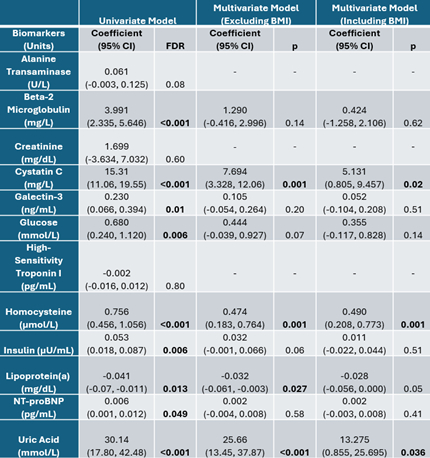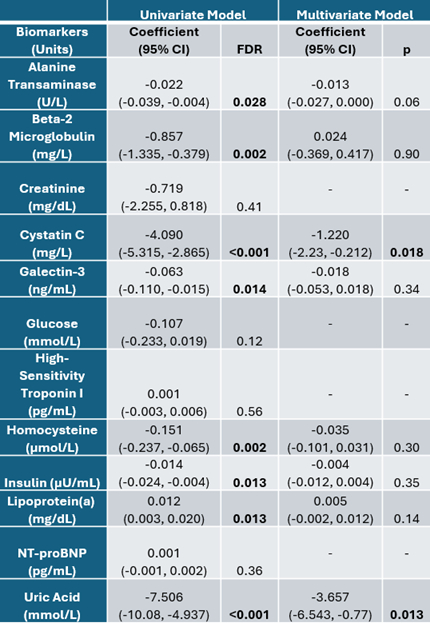Final ID: P3001
Associations of Biomarkers with Epicardial Adipose Tissue Volume and Density in Cardiovascular Risk Assessment: Insights from the PROMISE Trial
Abstract Body: Introduction: Epicardial adipose tissue (EAT) has emerged as a potential biomarker due to its relationship with cardiovascular (CV) events. This study leverages data from the PROMISE trial to investigate relationships between EAT characteristics and biomarkers related to metabolic and CV health.
Hypothesis: We hypothesize that specific biomarkers are significantly associated with CTA-derived EAT volume (EATv) indexed by body surface area (EATv/BSA) and EAT density (EATd), even after adjusting for clinical variables.
Methods: We analyzed 1,544 individuals (mean age: 60.3 + 8.1 years; 52.9% female) with both CTA and blood samples. Biomarkers included alanine transaminase, beta-2 microglobulin, creatinine, cystatin C, galectin-3, high-sensitivity troponin I, glucose, homocysteine, lipoprotein(a), insulin, NT-proBNP, and uric acid. Univariate models assessed the direct relationship between each biomarker and EATv/BSA and EATd. False Discovery Rate (FDR) correction was applied. Significantly associated biomarkers were tested in multivariate models adjusted for age, sex, race, diabetes, hypertension, statin use, and smoking status. For EATv/BSA, models both with and without BMI were considered, due to EATv’s strong association with BMI. For EATd, the multivariate model adjusted for BMI and EATv.
Results: Cystatin C, homocysteine, and uric acid were positively associated with EATv/BSA with statistical significance in both univariate and multivariate models (Table 1). Lipoprotein(a) was significant in both the univariate model and multivariate model excluding BMI, but not in the multivariate model including BMI. Cystatin C and uric acid were negatively associated with EATd, with statistical significance in both univariate and multivariate models (Table 2).
Conclusions: This study identifies cystatin C and uric acid as significant biomarkers associated with both EATv and EATd in individuals with suspected CAD. The relationship between EAT and these biomarkers may reflect underlying metabolic disturbances, with obesity potentially contributing to higher excretion of cystatin C and elevated uric acid levels. Understanding these associations can enhance cardiovascular risk prediction models, leading to more targeted and effective interventions.
Hypothesis: We hypothesize that specific biomarkers are significantly associated with CTA-derived EAT volume (EATv) indexed by body surface area (EATv/BSA) and EAT density (EATd), even after adjusting for clinical variables.
Methods: We analyzed 1,544 individuals (mean age: 60.3 + 8.1 years; 52.9% female) with both CTA and blood samples. Biomarkers included alanine transaminase, beta-2 microglobulin, creatinine, cystatin C, galectin-3, high-sensitivity troponin I, glucose, homocysteine, lipoprotein(a), insulin, NT-proBNP, and uric acid. Univariate models assessed the direct relationship between each biomarker and EATv/BSA and EATd. False Discovery Rate (FDR) correction was applied. Significantly associated biomarkers were tested in multivariate models adjusted for age, sex, race, diabetes, hypertension, statin use, and smoking status. For EATv/BSA, models both with and without BMI were considered, due to EATv’s strong association with BMI. For EATd, the multivariate model adjusted for BMI and EATv.
Results: Cystatin C, homocysteine, and uric acid were positively associated with EATv/BSA with statistical significance in both univariate and multivariate models (Table 1). Lipoprotein(a) was significant in both the univariate model and multivariate model excluding BMI, but not in the multivariate model including BMI. Cystatin C and uric acid were negatively associated with EATd, with statistical significance in both univariate and multivariate models (Table 2).
Conclusions: This study identifies cystatin C and uric acid as significant biomarkers associated with both EATv and EATd in individuals with suspected CAD. The relationship between EAT and these biomarkers may reflect underlying metabolic disturbances, with obesity potentially contributing to higher excretion of cystatin C and elevated uric acid levels. Understanding these associations can enhance cardiovascular risk prediction models, leading to more targeted and effective interventions.
More abstracts on this topic:
A Site-by-Site Comparison of CT Attenuation, Effective Atomic Numbers, and Electron Densities of Focal Pericoronary Adipose Tissue and Its Relationship to Adjacent Coronary Plaques on Contrast Enhanced Spectral CT
Kaneko Aya, Sakaguchi Yamato, Funabashi Nobusada
A Multi-centre, Randomized, Controlled Study of External CounterPulsation for Patients with Recent Atherosclerotic Stroke (SPA)Xiong Li, Chen Xiangyan, Leung Howan, Zhu Lixia, Leung Thomas, Wong Lawrence


